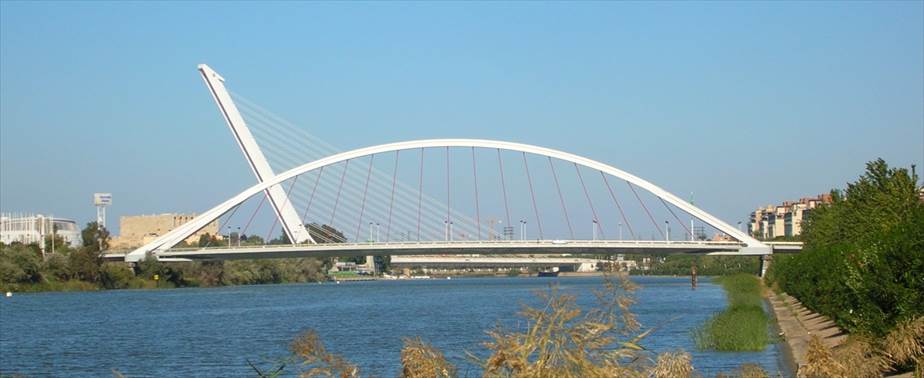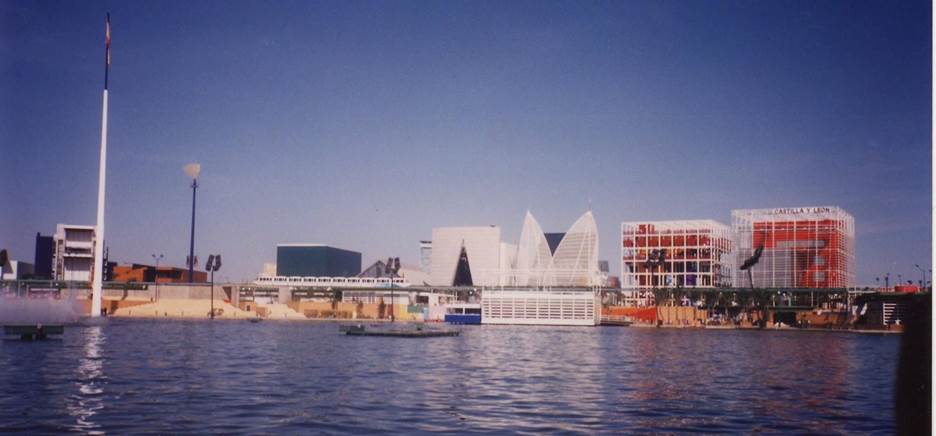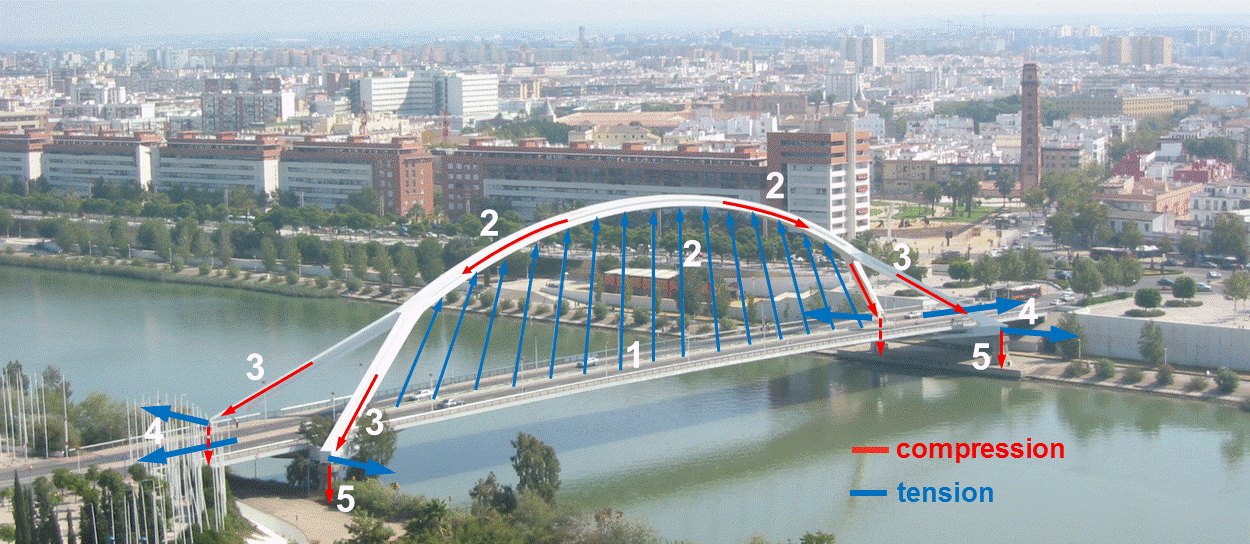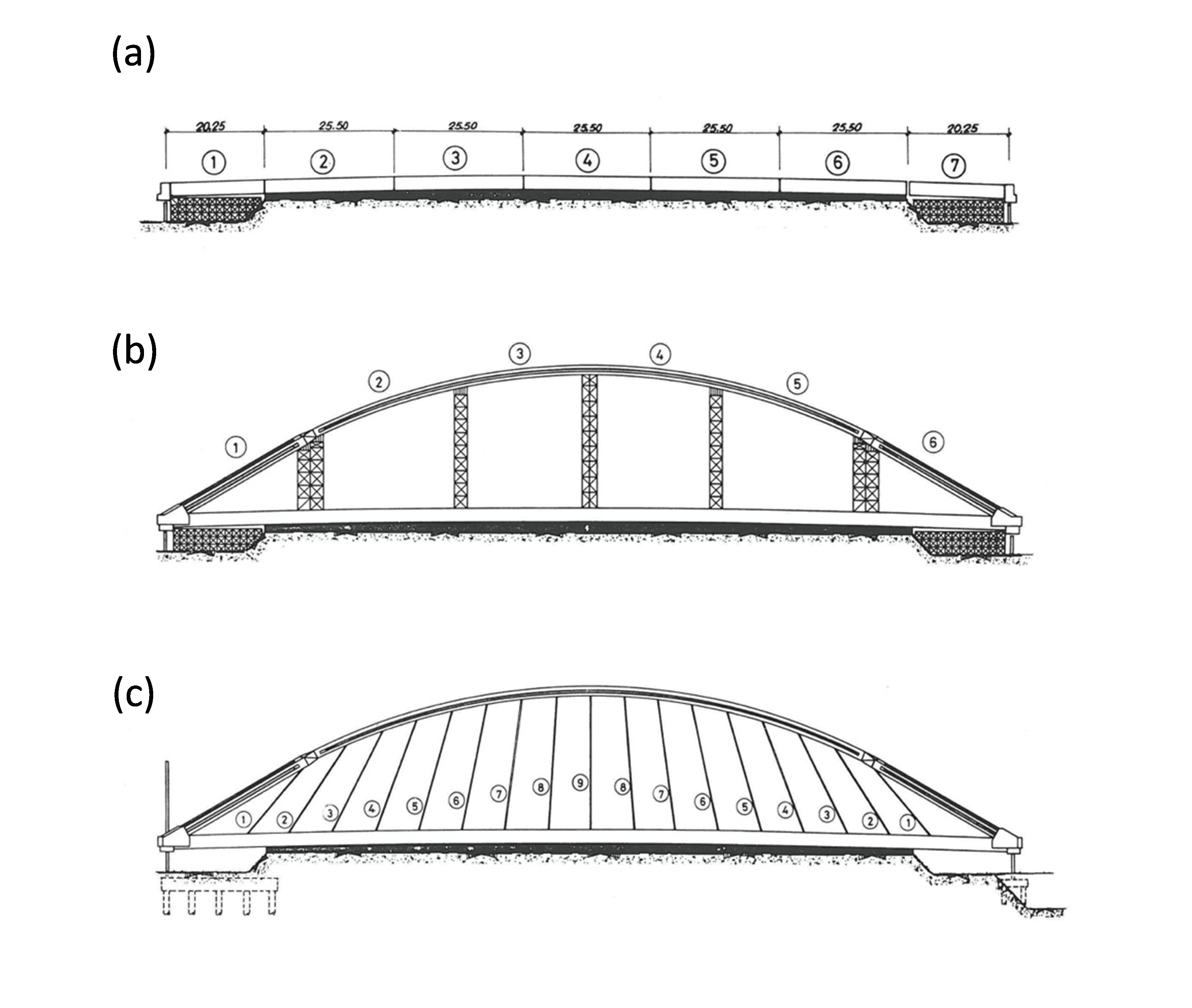Barqueta Bridge - photo: Michiel1972/Wikimedia Commons
Design engineers: Juan José Arenas and Marcos Pantaleón
Owner: City of Seville
Built: 1989 – 1992
Contractor: Joint venture Auxini -Ensidesa
Main Span: 168 meters (551 feet)
Total Length: 198.8 meters (652 feet)
Structural System: tied arch (bowstring)
The 1992 Universal Exposition of Seville
Barqueta Bridge (see figures 1 and 2) designed by J.J. Arenas and M. Pantaleón was the result of a design competition for one of the bridges built for the 1992 Universal Exposition in Seville, Spain. The site of the Universal Exposition was La Cartuja, an island near Seville that was completely redeveloped for the expo. Given the influx of visitors from the Expo—42 million of visits in a 6-month period—several bridges were needed to cross the Guadalquivir River to connect the island to the rest of the city.

Figure 1 . The Barqueta Bridge with the Alamillo Bridge, a cable-stayed bridge designed by S. Calatrava, in the background. Photo: G. Zeier / Wikimedia Commons.

Figure 2 . Pavilions at the Seville Universal Exposition. Photo: Sitomons / Flickair.
The theme of the Expo was “The Age of Discovery,” and La Cartuja Island was chosen because it is the historic site for the Carthusian Monastery, where Columbus lived while preparing for his voyage to America and where he was buried for several years. Gardens and pavilions in the themes of Discovery, Navigation, Nature, Environment and the Fifteenth Century were constructed for the Expo (see Figure 2 ). The transformation of the island was at the time considered the largest public works project of the decade in Europe.
The Expo hosted 112 countries, the Spanish autonomous communities and 24 organizations. The Expo spanned from April 20th to October 12th, a date that coincided with the 500th Anniversary of the Discovery of America. For those six months of the Expo, La Cartuja Island was transformed into a space of fantastical qualities and impressive architecture, and Seville was seen “the capital of the world.”
The Expo not only generated large amounts of employment but also strengthened ties between Seville and the rest of the world. Both Expo 92 and the bridges that were built for it helped transform Seville, and bring it to the world stage. Felipe González, who was the president of the Spanish government at that time, pushed for the Expo, which brought Seville much improved infrastructure and tourism.
Although many of the pavilions were dismantled after the Expo, the remaining spaces have been transformed into schools, exhibition spaces, a research and development park called Cartuja 93, as well as the theme park, Isla Mágica. As one of the main entry points onto La Cartuja Island, Barqueta Bridge is still seen as a symbol for the 1992 Expo and for the city of Seville [1].
The Split Bowstring Arch: An Innovative Structural System
The Barqueta Bridge is a bowstring steel bridge over the Guadalquivir River with a total length of 198.8 m. The main arch spans 108 meters and it splits into two inclined struts on either end, forming two triangular end frames as seen in Figure 3 . This split arch form is one of the first of its kind, and is an innovative way of increasing the main span of the bridge without decreasing the buckling load of the arch. The triangular frames not only extend the lateral length of the arch bridge as they receive the axial force of the arch, but also allow for an increase in the width of the bridge because of the transverse bracing they provide. In addition to their structural importance, the triangular frames also serve as a symbolic gateway into Cartuja Island [1].

Figure 3. Triangular end frames serve as a gateway to La Cartuja Island. Photo: Ignacio Payá-Zaforteza.
Flow of Forces
Even though the bridge seems simple and elegant with minimal number of elements, the geometry of each element as well as the system for load transfer is rather complex (see Figure 4). The dead load of the deck as well as the live loads are transferred from the deck (1) via the cables to the main arch (2). Under the loads, the arch is in compression (2). The flow of forces in the arch is continued on either end by triangular frames (3). The two struts of each frame are in compression, and push outwards at the base of the triangle. Therefore, a horizontal tie is required to resist outward forces. The deck is connected to the base of the frames, and acts as a tension tie that resists the horizontal forces from the arch (4). The structure then rests on four concrete piers (5).

Figure 4. Flow of forces in the bridge. Image done by I. Payá-Zaforteza based on an image from Arenas & Asociados.
Structural Elements
The deck has a hollow steel trapezoidal cross-section that is 21.4m wide and 2.4m thick. The deck is very thin and the inclined planes of the trapezoidal section create an additional sense of lightness. Transverse stiffening frames made up of steel I-beams in the deck are spaced 4.25m apart along a central truss that runs along the length of the bridge (see Figure 5 ). These frames provide bending stiffness to the deck and prevent distortion of the deck cross-section.

Figure 5. Cross sectional drawing of the trapezoidal hollow steel deck. Source: Arenas and Pantaleón [4].
The cable hangers connect from the center of the deck to the main arch and transfer loads to the arch. In order to avoid any interference with traffic, the single plane of cables can only connect to the main arch and not to the struts. Therefore, the bridge’s seventeen cables are spaced 6.75m apart along the arch and 8.5m apart along the deck and are thus inclined. The inclination of the cables and the red plastic protective coating create a dynamic visual rhythm.
The cross section for the arch and the struts is very innovative as J.J. Arenas came up with the idea of adding grooves in the steel plates that define its cross section (Figure 6) [2, 3]. These 300mm deep grooves are visually appealing, provide stiffness and prevent buckling of the steel plates.
Figure 6. Typical rectangular cross sections contain stiffeners inside while the cross sections of the Barqueta Bridge form a grooved shape, eliminating the need for stiffeners. Source: Li et al. [5].
Construction Process
The bridge was constructed along the bank of the Guadalquivir River (see Figure 7). The deck and the arch were installed in segments supported by scaffolding (see figures 8a and 8b). Once the segments were welded together, hangers were installed and tensioned (Figure 8c). The structure was then swung across the river into place. A temporary hinge was created on end of one of the bridge as a pivot for rotation. After rotation, the concrete abutments were cast and the bridge secured in its final position. These steps are described in Figure 9.

Figure 7. The Barqueta Bridge under construction on one shore of the Guadalquivir River. Source: Arenas & Asociados.

Figure 8. Drawings showing the construction of the bridge on the Guadalquivir river bed. Source: Arenas and Pantaleón [4].

Figure 9. Drawings showing the Barqueta Bridge being swung into place. Source: Arenas and Pantaleón [4].
Legacy After the Expo
The Barqueta Bridge is significant in that the split arch design of the bridge is one of the first of its kind. Following the conclusion of the Universal Exposition in 1992, the positive exposure of the bridge led to more split arch designs being built around Spain, and the world. One bridge inspired by the Barqueta Bridge is the Third Millennium Bridge (see Fig. 10), located in Zaragoza, Spain, which was built in 2008 and was also designed by Arenas.

Figure 10. The Third Millenium Bridge (Puente del Tercer Milenio) features a split arch design similar to the Barqueta Bridge. Source: Arenas & Asociados.
Conclusions
While outsiders to Seville are more likely to recognize Calatrava’s Alamillo Bridge, located about a kilometer upstream, the Barqueta Bridge plays an important role within the city of Seville. The bridge serves as an important connector between the mainland and La Cartuja Island, and is easily recognized by residents of Seville as one of the bridges crossing the Guadalquivir River. The pureness of the structure expresses a visual flow of forces that is dynamic and powerful. The inclined hangers generate a sense of dynamism for both vehicles and pedestrians using the bridge (Figure 11). Although the geometric shapes are complex, the structure is clean and expresses grandness and elegance.

Figure 11. Pedestrians (part of the group of Princeton students participating in the CEE463 course) walking across the Barqueta Bridge. The distinctive red cables of the Barqueta are in the foreground and the Alamillo Bridge can be seen downstream in the background. Photo: Ignacio Payá-Zaforteza.
References
[1] Arenas & Asociados. "Puente de la Barqueta". www.arenasing.com. Retrieved on October 4th, 2014.
[2] J.J. Arenas and M.J. Panteleón. “Barqueta Bridge, Sevilla, Spain”. Structural Engineering International 2(4): 251-252, 1992.
[3] G. Capellán Miguel. Interview conducted by J. Li, J. Luo and K. Tresselt
at Princeton University, October 9th, 2014.
[4] J.J. Arenas and M.J. Pantaleón. "Proyecto de construcción de la Pasarela de la Barqueta", 1988. In Spanish.
[5] J. Li, J. Luo and K. Tresselt. “Barqueta Bridge”. Report submitted for the fulfillment of the requirements of the course “CEE 463. A Social and Multi-Dimensional Exploration of Structures”, Princeton University, 2015.
